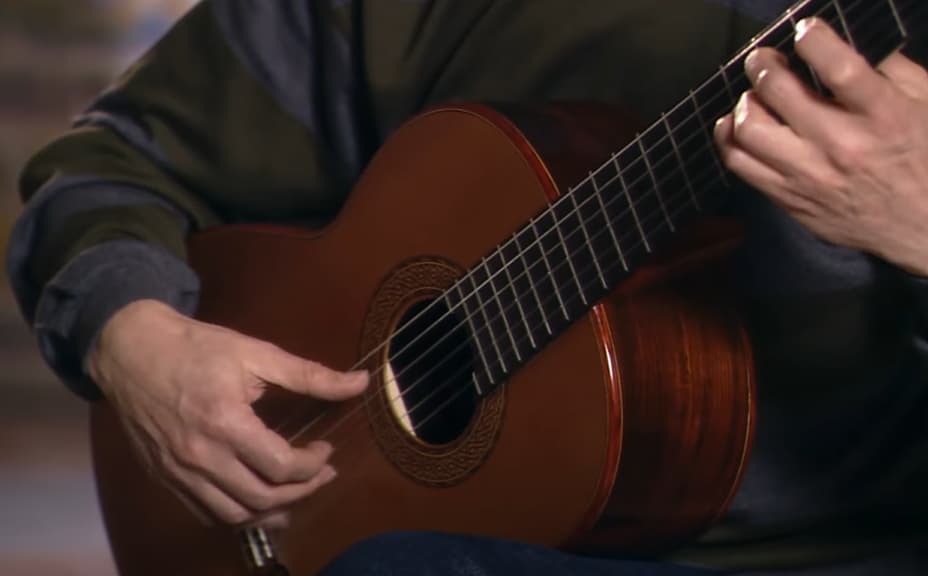This is sort of funny. I was about to post a pic of the first classical guitarist I could think of showing how obvious this is. Actually, you aren’t wrong. You’ve probably never seen any classical guitarist do this. I had more trouble finding ones that did than those who seem to hold it pretty straight.
I was trained in the classical technique by Julian Gray of the Peabody Conservatory. It’s a world renowned conservatory (not quite Juliard, but up there) and he’s very respected, particularly for his tone production, and that was the basis of everything he showed me - how to coax the best possible sounds from the instrument. He did instruct me to angle the guitar away from my body with the explanation that I needed to keep the back of the instrument free to resonate.
I should point out (and no judgement here at all) that if someone is just a ‘casual’ classical guitar fan/player, this stuff isn’t on their radar. The training I received was with the thought that I’d go on to become someone who performs classical guitar for a living and there are considerations that the general guitar public (even ones interested in elite guitarists like close to 100% of us here are) just doesn’t think about. Also, unless these considerations are done on a high quality very resonant instrument, it’s highly possible there would be no difference if you let the back of the instrument touch your body or not. If a guitar isn’t built in a way that allows a high amount of resonance from the back…then stopping that resonance (that isn’t very present to begin with) won’t make much difference. My instrument, while nothing to brag about in relative terms, was hand built by a regionally respected classical guitar luthier and I could definitely hear a pronounced difference on my guitar if I didn’t angle it away from me. I paid $2K for it in the year 2000. Julian told me I’d purchased a nice instrument. He told me his cost $10K, just for perspective  You may not notice any difference if you walk into a guitar center and try one of their mass produced ‘classical’ guitars. They aren’t necessarily built with the intent of giving public performances in a small concert venue, no mic used.
You may not notice any difference if you walk into a guitar center and try one of their mass produced ‘classical’ guitars. They aren’t necessarily built with the intent of giving public performances in a small concert venue, no mic used.
Anyway, here’s a video of Julian where it’s clear that he’s angling the instrument away from himself.
Here’s an image of Manuel Barrueco, another Peabody guy and there’s a clear tilt
Here’s Christopher Parkening (my favorite ‘tone’ guy of the genre) - tilted
David Russell (considered by many the “best” we have, alive today) - tilted
So that’s me cherry-picking data  and now you can’t say you’ve never seen ‘any’ classical guitarists do this. I’ll gladly eat my words and walk back any sentiment that they ‘all’ do this. I’d honestly never given it much thought and just done things the way Julian taught me, assuming since he was a prominent instructor in a realm where technique doesn’t vary that much, that’s what everyone else did too.
and now you can’t say you’ve never seen ‘any’ classical guitarists do this. I’ll gladly eat my words and walk back any sentiment that they ‘all’ do this. I’d honestly never given it much thought and just done things the way Julian taught me, assuming since he was a prominent instructor in a realm where technique doesn’t vary that much, that’s what everyone else did too.
In fairness, here’s John Williams, regarded as the supreme technician of classical guitar. He has great tone also…looks like he holds the guitar pretty ‘straight’ and looks quite different from the rest. I found plenty of others who hold the instrument like he does.
And finally, since I’m constantly trying to market the music of Barrios in hopes to make the world a better place, here’s an assortment of artists, all varying degrees of the ‘tilt’ (or in some cases, the absence of a tilt).
To keep it back on topic, there’s plenty examples in this video of ways to press just hard enough. I’ve played some of these pieces and they are brutal on the left hand. If you don’t do it the ‘right’ way (or at least, not too much of the wrong way lol), you can’t get through the pieces.








